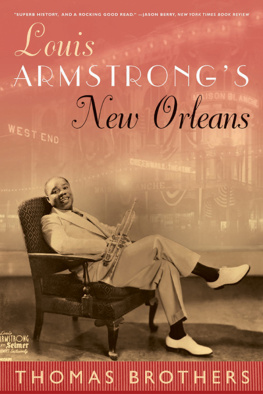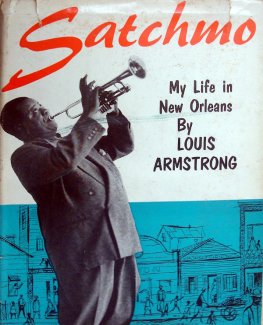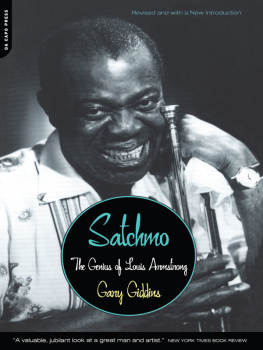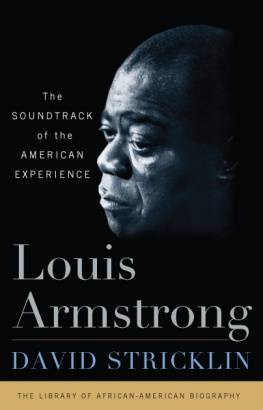

Louis Armstrongs
New Orleans
THOMAS BROTHERS

W. W. NORTON & COMPANY
New York London
Images in this ebook are not displayed owing to permissions issues.


For Leo & Roger


In the early 1990s I had the good fortune to begin work on an edition of Louis Armstrongs unpublished writings, eventually published as Louis Armstrong, In His Own Words. As I tried to contextualize what Armstrong was saying, I realized how much American musicology has neglected the early period of jazz in New Orleans. Some excellent work has been done, but by a very small number of people. I traveled to New Orleans, visited the archives, and got a sense of the possibilities. Now that I have finished the present book, the range of possibility seems even greater than it did when I started.
Armstrong produced dozens of accounts of his early life, in interviews and written memoirs. To these we may add autobiographies written by a few of his contemporaries, plus hundreds of extended interviews with many more of them. The result is an extremely rich body of first-person accounts. This diverse collection of memories gives us a chance to view the emerging world of jazz from the inside.
The body of first-person accounts for early jazz in New Orleans is exceptional, yet this information is hardly without problems. Most of the accounts were generated decades after the events that concern us. Memory can fade and it can be substantially restructured. In the end, however, using oral histories is no different from using any other primary source in the sense that the historian must assess the information, weighing it against all other sources and trying to understand how it was shaped and what interpretation it will most responsibly serve.
I have tried to provide a substantial set of references to the oral histories I have used, with the goal of assisting scholars. It would be wrong to regard the references cited here as proof of any assertion in my text. This book is not the place to explain every decision regarding the validity of the evidence, but the reader should realize that such decisions were constantly made. It would please me immensely if the references provided here assist future investigation.
Bibliographic citations are of two kinds, general sources (mostly published works, with the exception of a few dissertations and unpublished research papers) and unpublished sources held in archives; the latter are distinguished by an abbreviation referencing the place where the document is held, inserted after the author and before the date (e.g., Keppard HJA 1957). References in the endnotes are keyed to the main body of the book through a system of page numbers and key phrases.
Acknowledgments
Olly Wilsons views on jazz as part of African-American history have shaped my thinking ever since my first semester in graduate school. That same semester I also met Scott DeVeaux, who, over the years, has taught me more about jazz than anyone. Rich Crawford first suggested that I visit the Hogan Jazz Archive, and I am grateful for all of his generous support. Charley Kinzer has shared his deep knowledge of New Orleans, jazz, and Louisiana with me; he was kind enough to read a draft of the present book, improving it immensely. Jim Manheim, who has, for a long time, shared with me his insights into American culture, did the same. At Norton, I am deeply indebted to Maribeth Anderson Payne, whose loyalty and commitment to this book have been sources of inspiration, and to Mary Babcock, whose meticulous copyediting has been a marvel to behold.
Early presentations of parts of this book were read at McGill University (my thanks to Julie Cumming), the University of North Carolina at Chapel Hill (thanks to Jim Ketch), and a conference on Louis Armstrong in Milan (thanks to Stefano Zenni and all the participants). Lawrence Gushee, whose work on New Orleans cont inues to set musicological standards, gave helpful advice at several turns. Jeff Taylor, Brian Harker, Eric Simpson, Jairo Moreno, Anthony Kelly, T. J. Anderson, and Paul Berliner all helped me by either providing materials or talking through parts of this book with me. I am also indebted to Michael Cogswell of the Louis Armstrong House and Archive, Dan Morgenstern of the Institute of Jazz Studies, Nathan Salsburg of the Alan Lomax Archive, Wayne Everard at the New Orleans Public Library, John Magill at the Williams Research Center, and John Druesedow of the Music Library at Duke University. My research trips to New Orleans and New York were generously supported by grants from the Arts and Sciences Council for Faculty Research at Duke University.
Work on this book benefited immensely from a fellowship at Duke Universitys John Hope Franklin Institute, supported by a grant from the Mellon Foundation called Making the Humanities Central. Fellows Rick Powell, Lee Baker, and Maurice Wallace were especially generous with their knowledge. A Duke Endowment fellowship allowed me to further my inquiry through a fellowship at the National Humanities Center, where a wonderful group of scholars read and commented on parts of this book; I wish to thank Jim Peacock, Brad Weiss, Elizabeth Kennedy, Lew Erenberg, Jordanna Bailkin, Carol Summers, Lee Baker, Jeffrey Kerr-Ritchie, Brian Kelley, and Gabrielle Foreman. At the NHC I also benefited from a musicology reading group with Wendy Allanbrook, Susan Youens, and Larry Zbikowski. I am grateful to Sam Floyd not only for his scholarship and his personal support but also for a year of stimulating lunchtime conversations at the NHC during our time there together.
I know what it means to miss New Orleans, since Ive spent a good bit of time there researching the material for this book. Connie Atkinson, Tony Cummings, John Joyce, Jack Stewart, and Tad Jones were all gracious with their hospitality and generous with their knowledge. So were the staffs of the two main archives I worked at, the Williams Research Center and, especially, the Hogan Jazz Archive, where Charles Chamberlain, Lynn Abbott, and Alma Freeman were of tremendous help. Richard and Debbie Snyder and Giuseppe Gerbino helped me in many ways during my visits to New York City.
Charles Chamberlain, formerly on the staff at the Hogan Jazz Archive and now at the Louisiana State Museum, has been a steady source of local and global knowledge. He read this manuscript and offered numerous suggestions. And finally, it is a pleasure to acknowledge the greatest scholarly debt I incurred while writing this book, which is to Bruce Boyd Raeburn, curator of the Hogan Jazz Archive, who gave me something of a personal tutorial in the intricacies of his archive and early jazz. Without Bruces deep knowledge and generous spirit, this book simply would not have been possible.
My greatest personal debt is to my family, to Tekla, as always, and to Leo and Roger in this case, especially.

Next page














